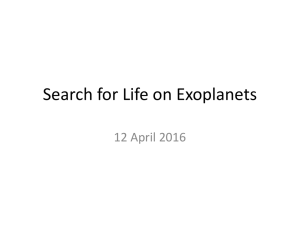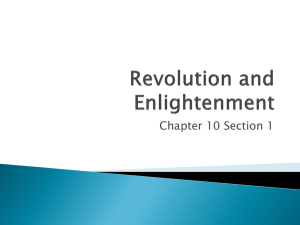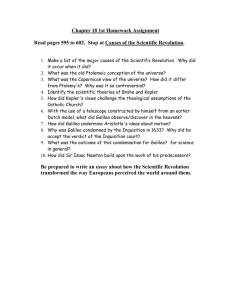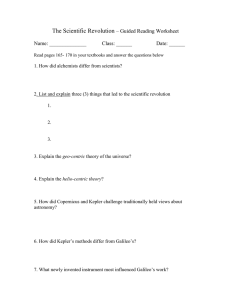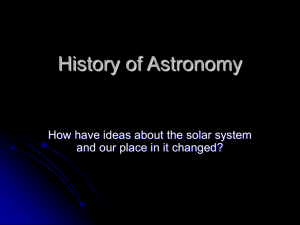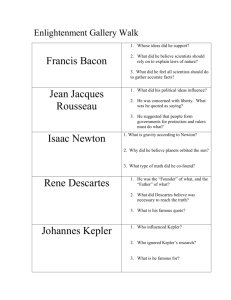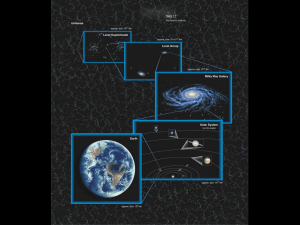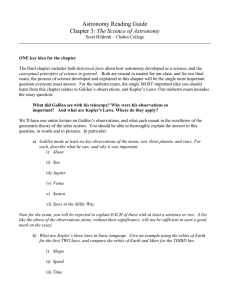The idealized scientific method • Based on proposing and testing hypotheses
advertisement
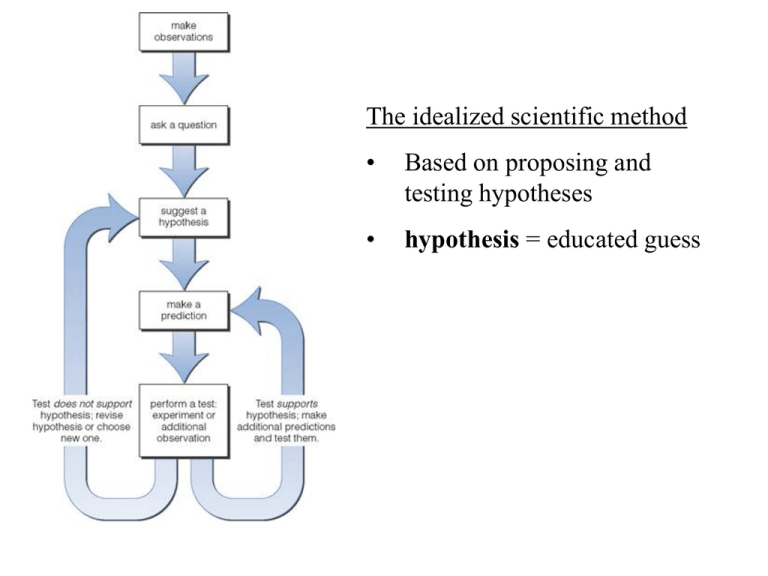
The idealized scientific method • Based on proposing and testing hypotheses • hypothesis = educated guess Hallmarks of Science: #1 Modern science seeks explanations for observed phenomena that rely solely on natural causes. (A scientific model cannot include divine intervention) Hallmarks of Science: #2 Science progresses through the creation and testing of models of nature that explain the observations as simply as possible. (Simplicity = “Occam’s razor”) Hallmarks of Science: #3 A scientific model must make testable predictions about natural phenomena. The world view of Aristotle (384-322 B.C.) Adopted as a part of Western tradition, and by the Catholic Church • The Earth is stationary • The planets Mercury, Venus, Mars, Jupiter, and Saturn, as well as the Sun and Moon, move in circular orbits around the Earth • The stars are fixed on the celestial sphere • The stars aren’t much farther away than the orbit of Saturn. Special Topic: Eratosthenes measures the Earth (c. 240 BC) Measurements: Syene to Alexandria distance ≈ 5000 stadia angle = 7° Calculate circumference of Earth: 7/360 (circum. Earth) = 5000 stadia circum. Earth = 5000 360/7 stadia ≈ 250,000 stadia Compare to modern value (≈ 40,100 km): Greek stadium ≈ 1/6 km 250,000 stadia ≈ 42,000 km How did the Greeks explain planetary motion? Underpinnings of the Greek geocentric model: • Earth at the center of the universe • Heavens must be “perfect”: Objects moving on perfect spheres or in perfect circles. Plato Aristotle But this made it difficult to explain apparent retrograde motion of planets… Review: Over a period of 10 weeks, Mars appears to stop, back up, then go forward again. The most sophisticated geocentric model was that of Ptolemy (A.D. 100-170) — the Ptolemaic model: • Sufficiently accurate to remain in use for 1,500 years. • Arabic translation of Ptolemy’s work named Almagest (“the greatest compilation”) Ptolemy Claudius Ptolemaeus [Ptolemy] (87-150 A.D.) • Embraced Aristotle’s view of Earth-centered Universe • And endorsed the idea of perfect circles • But, he improved predictions of the positions of the planets by introducing additional perfect circles to Aristotle’s model. • These additional circles are known as epicycles. Fig 1-13, p.31 Nicolaus Copernicus (1473-1543) Copernicus found the old model of Ptolemy gave incorrect positions of the planets. He developed the Sun-centered (heliocentric) view of the Universe, which improved the predictions of planetary positions. How did Copernicus, Tycho, and Kepler challenge the Earth-centered idea? Copernicus (1473-1543): • Proposed Sun-centered model (published 1543) • Used model to determine layout of solar system (planetary distances in AU) But . . . • Model was no more accurate than Ptolemaic model in predicting planetary positions, because it still used perfect circles. Fig 1-15, p.34 Johannes Kepler and Tycho Brahe Tycho made many observations of the positions of the planets and stars, before the invention of the telescope. Kepler used those observations, particular those of Mars, to develop his three laws of planetary motion. What are Kepler’s three laws of planetary motion? Kepler’s First Law: The orbit of each planet around the Sun is an ellipse with the Sun at one focus. Kepler’s Second Law: As a planet moves around its orbit, it sweeps out equal areas in equal times. means that a planet travels faster when it is nearer to the Sun and slower when it is farther from the Sun. Kepler’s Third Law More distant planets orbit the Sun at slower average speeds, obeying the relationship p2 = a3 p = orbital period in years a = avg. distance from Sun in AU Galileo Galilei (1564-1642) A contemporary of Kepler Galileo was one of the very first scientists to do experiments to understand Nature He was the first astronomer to use a telescope (in 1610) to study the sky. Galileo’s most important discovery Galileo saw four little “stars” Moving with Jupiter across The sky, and changing their Positions every night. He quickly and correctly concluded that they are in orbit around Jupiter. This confirmed the Copernican view that the Earth is NOT the center of all motion in the Universe. How did Galileo solidify the Copernican revolution? Galileo (1564-1642) overcame major objections to Copernican view. Three key objections rooted in Aristotelian view were: 1. Earth could not be moving because objects in air would be left behind. 2. Non-circular orbits are not “perfect” as heavens should be. 3. If Earth were really orbiting Sun, we’d detect stellar parallax. Overcoming the second objection (heavenly perfection): • Tycho’s observations of comet and supernova already challenged this idea. • Using his telescope, Galileo saw: • Sunspots on Sun (“imperfections”) • Mountains and valleys on the Moon (proving it is not a perfect sphere) The Catholic Church ordered Galileo to recant his claim that Earth orbits the Sun in 1633 His book on the subject was removed from the Church’s index of banned books in 1824 Galileo Galilei Galileo was formally vindicated by the Church in 1992 Why do the planets move in the ways described by Kepler? Isaac Newton (1643-1717) Escape velocity Throw the ball hard enough and it will escape the gravity pull of the Earth How fast do you have to throw it? It depends on which planet you live on … Escape Velocity for the planets The velocity of escape, V, from a planet is given by V 2Gm / r G is the universal gravitational constant m is the mass of the planet r is the radius of the planet The escape velocity of Earth is 11 km/sec, or About 25,000 miles per hour. Escape Velocities for the planets, the Sun, and the Moon Object Sun Jupiter Saturn Neptune Uranus Venus Mars Mercury Moon Mass (Earth = 1) 330,000 318 95 17 15 0.8 0.11 0.05 0.012 Radius (Earth = 1) 109 11.2 9.5 3.4 3.7 0.96 0.52 0.38 0.27 Escape Velocity 620 km/sec 60.0 35.6 25.4 22.4 10.4 5.2 4.3 2.4
